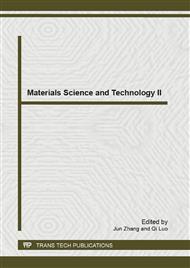[1]
T.S Huang, M.N Rahaman, B.S Bal. Alumina-Tantalum Composite For Femoral Head Applications In Total Hip Arthroplasty. C29. pp-1936-1941. (2009).
DOI: 10.1016/j.msec.2009.03.005
Google Scholar
[2]
Sidney Soclof. Design and Applications of Analog Integrated Circuits.First Edition. New Delhi:PHI Learning Private Limited. pp-27,38. (2008).
Google Scholar
[3]
S. Banerjee. J. Mathew, D.K Pradhan, S.P Mohanty , M. Ciesielski. Variation-Aware TED – Based Approach for Nano-CMOS RTL Leakage Optimization .24th International Conference on VLSI Design. (2011).
DOI: 10.1109/vlsid.2011.40
Google Scholar
[4]
Vyatkin A.F, ZinenkoV.IPustovit A.N, Agafonov Y.A. Ultra shallow p-n junction formation by ion implantation at high energy.(2002). pp-594-596.IEEE.
DOI: 10.1109/iit.2002.1258075
Google Scholar
[5]
Maria Aboy, Lourdes Pelaz, Luis A. Marques, Juan Barbolla. Atomistic Modelling Of Boron Activation And Deactivation For Ultra Shallow Junction Formation.(2003). pp-151-154.IEEE.
DOI: 10.1109/sispad.2003.1233659
Google Scholar
[6]
Sami Franssila. Introduction to Micro Fabrication.Second Edition.Wiley.pp-2,35
Google Scholar
[7]
R.Gunawan, M.Y.L Jung, E.G Seebauer, R.D Braatz. Optimal Control Of Rapid Thermal Annealing In A Semiconductor Process.Journal Of Processes Control(2004) 423-430.
DOI: 10.1016/j.jprocont.2003.07.005
Google Scholar
[8]
Maria Aboy, Lourdes Pelaz, Luis A. Marques, Juan Barbolla. Atomistic Modelling Of Boron Activation And Deactivation For Ultra Shallow Junction Formation.(2003). pp-151-154.IEEE.
DOI: 10.1109/sispad.2003.1233659
Google Scholar
[9]
K.R.C Mok, F.Benistant, R.S Teo, S.Chu. TCAD Modelling & Simulation Of Boron Deactivation In NMOS Carbon-Implanted Channel.2002 IEEE.
DOI: 10.1016/j.sse.2009.04.003
Google Scholar
[10]
SreenivasaRao, Ayyanna, G.Sekhar Reddy, Dr. V. MalleswaraRao. Performance of different CMOS logic Styles for Low Power and High Speed.International Journal of VLSI & Signal Processing Applications (2011).
Google Scholar
[11]
Maria Aboy. Lourdes Pelaz, Luis A. Marques. Atomistic Modelling Of Boron Activation And Deactivation For Ultra-Shallow Junction Formation. pp: 151-154. 2003 IEEE.
DOI: 10.1109/sispad.2003.1233659
Google Scholar
[12]
Thomas M.Parrill, Michael S.Ameen, Michael Graf, Richard Mazzola. A New Era For High-Current, Low-Energy Ion Implantation. Axcelis Technologies Inc.p.86, 1999.
Google Scholar
[13]
Vyatkin A.F, Zinenko V.I, Pustovit A.N, AgafonovYu.A. Ultra-Shallow P-N Junction Formation By Ion Implantation At High Energy?pp: 594-596, 2002 IEEE.
DOI: 10.1109/iit.2002.1258075
Google Scholar
[14]
W.Lerch, S.Paul, J.Niess,S.McCoy. Advanced Activation Trends For Boron And Arsenic By Combinations Of Single Multiple Flash Anneals And Spike Rapid Thermal Annealing. Materials Science and Engineering B 154-155 (2008) 3-13.
DOI: 10.1016/j.mseb.2008.08.017
Google Scholar
[15]
Y.Lai, N.S Bennett, C.Ahn, N.E.B Cowern. Transient Activation Model For Antimony In Relaxed And Strained Silicon.Solid-State Electronics 5 pg. 31173-1176. (2009)
DOI: 10.1016/j.sse.2009.08.003
Google Scholar
[16]
Jihun Oh, KijuIm, Won-ju Cho, Seongjae Lee. Ultra Shallow And Abrupt N+-P Junction Formations On Silicon-On-Insulator By Solid Phase Diffusion Of Arsenic From Spin-On-Dopant For Sub 50nm Si Metal-Oxide-Semiconductor Devices. Materials Science and Engineering B110 (2004) 185-189.
DOI: 10.1016/j.mseb.2004.03.016
Google Scholar


